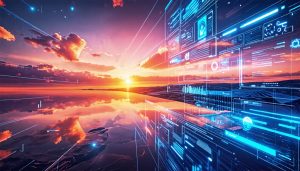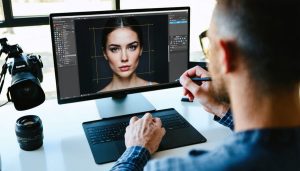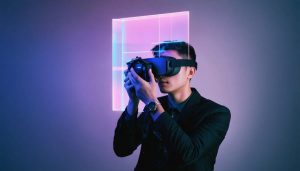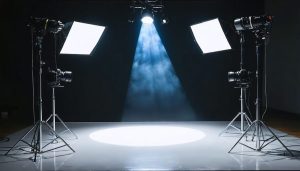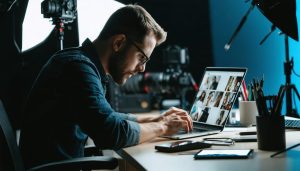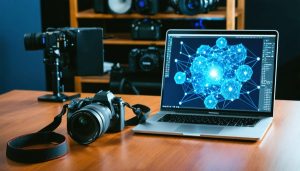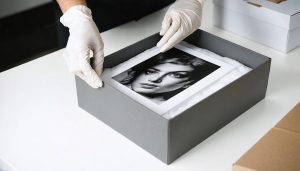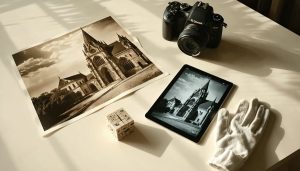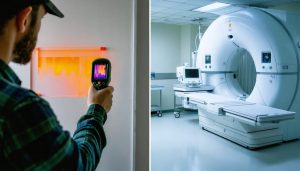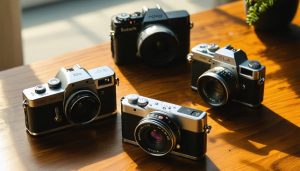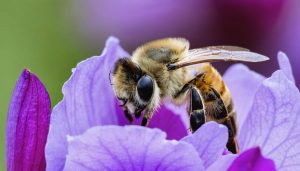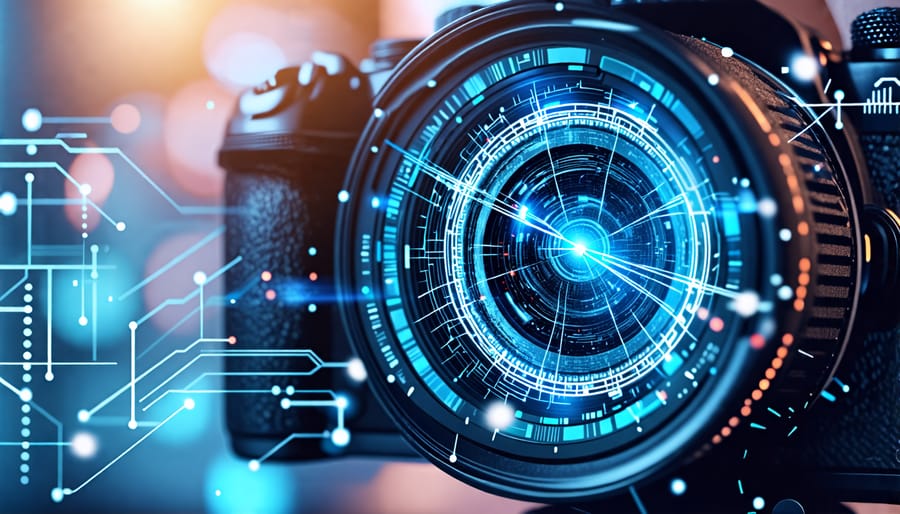
Explore how AI enhances photography by automating tasks such as image editing and scene recognition, allowing photographers to focus more on creativity. Leverage AI tools like Luminar Neo or Adobe Photoshop’s neural filters to quickly retouch photos, effortlessly removing imperfections and adjusting lighting. Experiment with AI-driven cameras that optimize settings based on detected scenes, ensuring optimal exposure and composition without manual adjustments. Implement AI platforms to analyze thousands of images quickly, identifying patterns and trends to refine your photography skills and strategy. By integrating AI into your workflow, you can enhance your technical capabilities while unleashing new creative possibilities.
Understanding AI in Photography
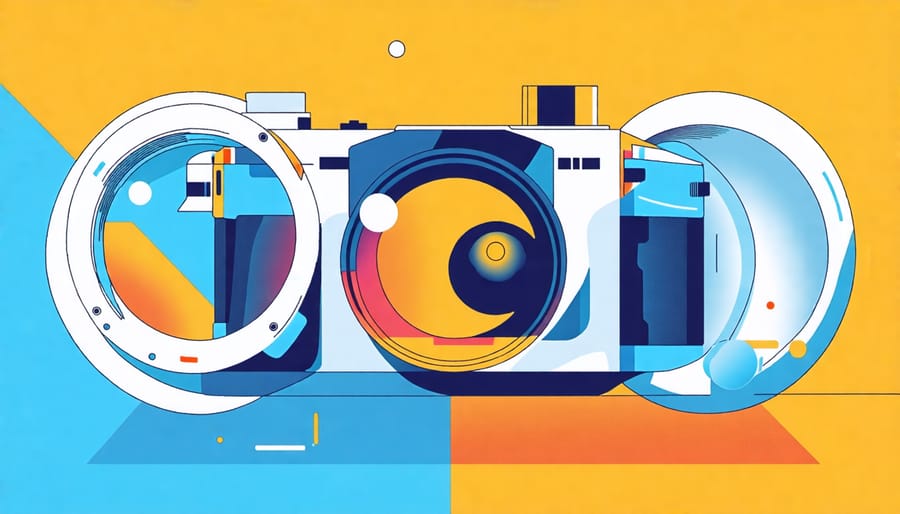
AI Technologies Behind the Lens
In the vibrant world of AI photography, technologies like machine learning, neural networks, and deep learning are transforming how we capture and process images. Machine learning algorithms are trained with vast datasets to recognize patterns and improve picture quality. They’re the secret sauce behind features like auto-enhance, which knows just how to adjust lighting or contrast for that perfect shot. Neural networks, inspired by the human brain, play a crucial role in tasks like ‘style transfer,’ where the essence of a painting can be applied to a photo, creating unique artistic expressions. Deep learning takes things a step further by driving advancements in object recognition and scene detection. This means your camera can identify whether you’re photographing a sunny beach or a twilight skyline and adjust settings accordingly. These technologies are not just making cameras smarter but are empowering photographers—whether hobbyists or professionals—to push creative boundaries and streamline their workflow. Imagine effortlessly achieving a professional grade shoot every time you hit the shutter.
How AI Enhances Photography
Imagine capturing a breathtaking skyline at dusk where the colors fade too quickly for human hands to adjust settings. This is where AI photography steps in, linking technology and artistry in remarkable ways. AI enhances photography through image recognition, which allows software to identify scenes, objects, and people, optimizing settings automatically for the best outcome. An adventurer in the Sahara, for instance, only needs to point their camera, and AI will handle exposure and color balance, focusing efforts on the shot itself.
Automatic adjustments cater to everyday photographers, making sophisticated edits without the need for technical prowess. Think of AI as an invisible assistant, instantly improving lighting, contrast, and even removing unwanted objects from a frame. This allows photographers—amateur and pro alike—to focus on their creative vision.
Additionally, AI-powered creative modes invite exploration by suggesting styles and compositions once limited by skill level or knowledge. It’s akin to having a seasoned mentor guiding your artistic journey, expanding the boundaries of what’s possible in photography.
The Impact of AI on Photography
Advantages of AI in Photography
In the world of photography, AI offers an exciting realm of possibilities, enhancing efficiency, creativity, and accessibility. Imagine the ease of automating repetitive tasks like organizing and editing photos. AI-driven tools can instantly sort through thousands of images, saving you valuable time and allowing you to focus on honing your photography skills. Additionally, AI’s creative potential is vast. With features like style transfer and intelligent scene recognition, photographers can explore new artistic directions and achieve results that were once considered too time-consuming or complex. AI also breaks down barriers to entry by making sophisticated photography techniques more accessible. Advanced editing tools that previously required a deep learning curve are now within reach for novices. This democratization of technology empowers more people to express their creativity through photography. Overall, AI is not just a tool but a vibrant partner in the photographic journey.
Challenges and Criticisms
AI photography, while groundbreaking, faces several challenges and criticisms that dampen the enthusiasm surrounding its potential. One key concern lies in the realm of authenticity. As AI-generated images blur the lines between reality and artistry, purists argue that photography may lose its essence as a medium that captures the truth of the moment. Picture-perfect landscapes and portraits, crafted from scratch by algorithms, raise questions about the originality and soul of such creations.
Another pressing issue is the devaluation of skill. With AI tools automating complex editing tasks and generating striking visuals with minimal human intervention, the traditional skills of a photographer may seem less vital. This shift has ignited debates around the appreciation of human craftsmanship versus machine efficiency. Enthusiasts and professionals alike worry that an over-reliance on AI could overshadow the unique vision and nuanced touch a human artist brings to the process.
Moreover, the accessibility of AI photography tools means that creating impressive images has never been easier. However, this democratization could potentially flood the market with AI-enhanced photos, making it challenging for individual artists to stand out. As we embrace AI’s capabilities, it’s crucial to reflect on these challenges, ensuring that technology enhances rather than diminishes the art of photography.
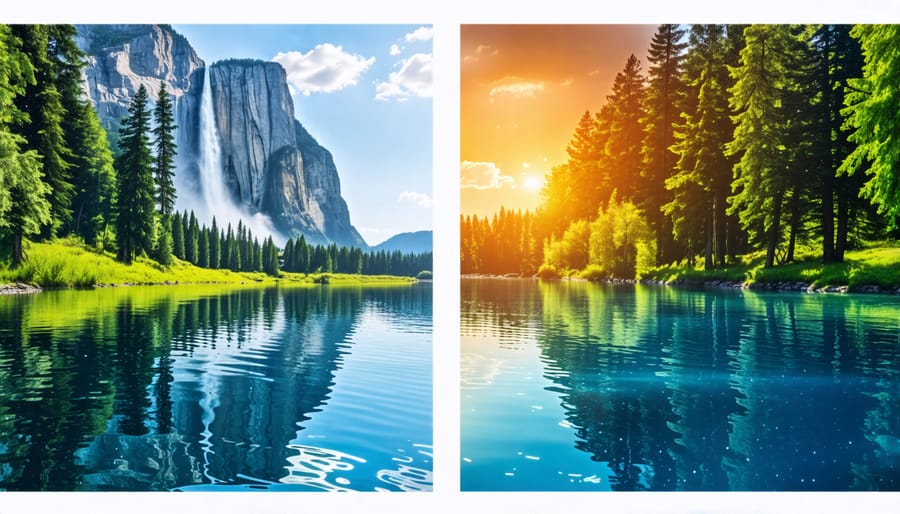
Real-World Applications of AI in Photography
Consumer Applications
AI photography has revolutionized how we capture and enhance images using smartphones and consumer cameras. With AI, these devices are now equipped with scene recognition capabilities. This means your phone can automatically identify the type of scene—be it a sunset, a bustling cityscape, or a serene portrait—and adjust settings on the fly to get the best shot. For example, in low-light conditions, AI might boost brightness and reduce noise, mimicking what a professional might do in post-production. Furthermore, automatic editing features refine photos in real-time. Think about those instances when you snap a picture, and your device instantly optimizes colors, sharpens details, and even removes unwanted elements, like photobombers. Apps like Google Photos offer AI-driven tools that suggest edits or improvements, often transforming ordinary photos into stunning compositions. This integration of AI not only democratizes photography, making advanced techniques accessible to all, but also enhances creativity by handling technical aspects, allowing photographers to focus on their artistic vision.
Professional Photographers and AI
In the realm of professional photography, AI has become a transformative tool that enhances both creativity and efficiency. Whether you’re a seasoned photographer or an enthusiastic hobbyist, artificial intelligence equips you with advanced techniques, creating opportunities to refine your craft. One crucial aspect where AI is making strides is post-processing, where it simplifies labor-intensive tasks like noise reduction or enhancing image sharpness. Using machine learning, AI software learns from vast datasets to automatically edit images with remarkable precision, allowing photographers to focus on creative decisions rather than technical adjustments.
Moreover, professionals are harnessing AI for photogrammetry, revolutionizing 3D modeling and virtual reality content creation. By stitching together multiple images, AI-driven software creates precise 3D representations of spaces or objects, which photographers can employ in diverse fields from architecture to gaming. This sophisticated approach enables photographers to explore new revenue streams and creative projects.
Beyond these advancements, AI also invites photographers to adopt more sustainable practices, thanks to more efficient workflows and reduced resource consumption. As AI continues to evolve, its potential lies not only in streamlining existing processes but also in pushing the boundaries of what’s possible, offering professional photographers a chance to reimagine their artistic horizons while balancing environmental considerations.
Future of AI Photography
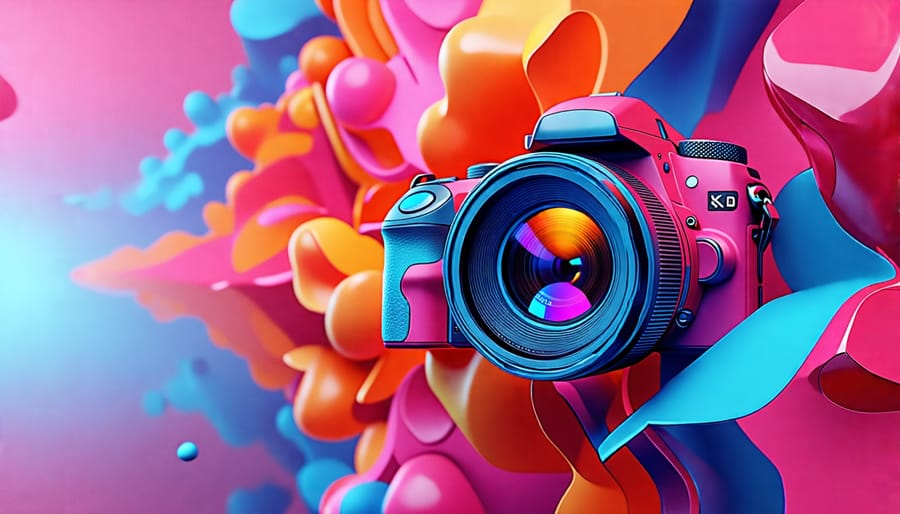
Technological Innovations on the Horizon
Imagine a world where AI not only enhances your photos but also understands your artistic intent. This is the promise of upcoming technological innovations in AI photography, poised to redefine how we capture and interact with images. Future AI advancements might offer cameras capable of learning your style, automatically adjusting to lighting conditions, and even suggesting compositions to elevate your shots. Emerging technologies like AI-powered image stabilization and real-time editing tools are already on the horizon, providing the potential for photographers to create stunning visuals with just a few clicks.
For those exploring the intersection of budget and technology, investing in affordable cameras equipped with AI capabilities is an exciting possibility. Envision AI systems that can analyze a scene for context and seamlessly integrate enhanced reality elements. The future may bring deeper integration with augmented reality, enabling photographers to visualize the end result while capturing the moment. These innovations promise not only to enhance creativity but also to streamline the photography process, making it accessible and inspirational for enthusiasts and professionals alike.
The Evolution of Photographer Roles
As AI technologies continue to evolve, photographers’ roles are set to transform in innovative ways. While AI can automate routine tasks like editing and sorting images, it offers photographers new creative tools to push boundaries. For example, AI-generated landscapes can inspire unique compositions or lighting techniques. These advancements can enhance skills, allowing photographers to focus more on storytelling and conceptual development. Embracing AI doesn’t mean replacing artistry; instead, it provides opportunities for photographers to refine their niche and automate tedious processes. By integrating AI, photographers can remain relevant and competitive, while still injecting their personal vision into every shot.
Conclusion
As we conclude our exploration of AI in photography, it’s clear that this technology is reshaping how photographers envision and create their art. By automating routine tasks like sorting and editing, AI allows photographers to focus more on their creative vision. Tools that enhance image quality, suggest compositions, or even generate entirely new visuals open exciting possibilities for both novices and professionals. However, understanding and harnessing these tools is key to staying competitive and innovative. As AI continues to evolve, photographers are encouraged to experiment with these technologies to enrich their work and push the boundaries of their creative expression.

